It looks like you're using an Ad Blocker.
Please white-list or disable AboveTopSecret.com in your ad-blocking tool.
Thank you.
Some features of ATS will be disabled while you continue to use an ad-blocker.
share:
reply to post by ProudBird
That's exactly my point, not only were the planes they used 'laden with explosives and torpedos' they ended up converting their planes into manned missiles, designed to penetrate the hull of ship and do more damage. The reason being regular planes weren't good enough!
It's the same thing at the world trade center, we have an explosive laden plane or a plane that's been modified into a computer guided bunker busting missile.
That's exactly my point, not only were the planes they used 'laden with explosives and torpedos' they ended up converting their planes into manned missiles, designed to penetrate the hull of ship and do more damage. The reason being regular planes weren't good enough!
It's the same thing at the world trade center, we have an explosive laden plane or a plane that's been modified into a computer guided bunker busting missile.
edit on 3-12-2011 by Insolubrious because: (no reason given)
reply to post by Insolubrious
No, there was no "conversion" needed. Some fighter/bombers were "modified" to carry heavier bomb loads, but that is something done anyway, as an airplane is in service, and more is learned. Such as reinforcing the landing gear so it won't collapse on takeoff. And, the added weight would normally affect the range, by using excess fuel....but, since it was a "one-way" mission, that was no longer a concern anymore.
READ the article. The airplanes themselves were the weapons of mass destruction. The pilots committed suicide, as a result of it being the only way to guide the airplane. There was no escape for them.
Many of them first dropped any bombs or torpedoes (depending on the type of airplane), and once all that ordinance was gone, ALL they had left was to sacrifice themselves and the airplane, and counted on the force of impact, and what remaining fuel they still had on board.
Near the very end of the War, the Japanese were hurriedly training young men and after they were barely able to know how to takeoff and fly, they were sent out with NO bombs or torpedoes. The only weapon was the airplane itself, and no there was no time to "convert" any of those airplanes. They were desperate, and in a hurry.
www.airgroup4.com...
No, there was no "conversion" needed. Some fighter/bombers were "modified" to carry heavier bomb loads, but that is something done anyway, as an airplane is in service, and more is learned. Such as reinforcing the landing gear so it won't collapse on takeoff. And, the added weight would normally affect the range, by using excess fuel....but, since it was a "one-way" mission, that was no longer a concern anymore.
READ the article. The airplanes themselves were the weapons of mass destruction. The pilots committed suicide, as a result of it being the only way to guide the airplane. There was no escape for them.
Many of them first dropped any bombs or torpedoes (depending on the type of airplane), and once all that ordinance was gone, ALL they had left was to sacrifice themselves and the airplane, and counted on the force of impact, and what remaining fuel they still had on board.
Near the very end of the War, the Japanese were hurriedly training young men and after they were barely able to know how to takeoff and fly, they were sent out with NO bombs or torpedoes. The only weapon was the airplane itself, and no there was no time to "convert" any of those airplanes. They were desperate, and in a hurry.
7,465 Kamikazes flew to their deaths
120 US ships were sunk, with many more damaged
3,048 allied sailors were killed and anther 6,025 wounded
www.airgroup4.com...
reply to post by Insolubrious
Untrue.
The fuel itself on board was the "explosive". The photos of United 175 are crystal-clear proof, it is a stock Boeing 767. All other claims are not only speculative, they are absent any common sense nor evidence.
It's the same thing at the world trade center, we have an explosive laden plane or a plane that's been modified into a computer guided bunker busting missile.
Untrue.
The fuel itself on board was the "explosive". The photos of United 175 are crystal-clear proof, it is a stock Boeing 767. All other claims are not only speculative, they are absent any common sense nor evidence.
Originally posted by ProudBird
reply to post by Insolubrious
It's the same thing at the world trade center, we have an explosive laden plane or a plane that's been modified into a computer guided bunker busting missile.
Untrue.
The fuel itself on board was the "explosive". The photos of United 175 are crystal-clear proof, it is a stock Boeing 767. All other claims are not only speculative, they are absent any common sense nor evidence.
I would suspect the modifications were internal.
reply to post by ProudBird
Yeah sure plenty of them just dive bombed the ships when they ran out of munition but they were useless which is why they deployed modified planes as guided missiles designed to take down ships, of which they made over 700 of them:
And let's face it, according to your numbers 7,465 kamikaze pilots isn't a very good turn around for 120 battleships sunk!
On 9/11 we had 2 kamikaze planes take out 3 buildings, 2 of which contained more steel than 10 class A battleships!!
Yeah sure plenty of them just dive bombed the ships when they ran out of munition but they were useless which is why they deployed modified planes as guided missiles designed to take down ships, of which they made over 700 of them:
he Yokosuka MXY-7 Ohka (櫻花; Shinjitai: 桜花; "cherry blossom"; Hebon-shiki transcription Ōka) was a purpose-built, rocket powered human-guided anti-shipping kamikaze attack plane[1] employed by Japan towards the end of World War II. United States sailors gave the aircraft the nickname Baka[2] (Japanese for "fool" or "idiot").[3]
Kugisho/Yokosuka MXY-7 "Ohka" Model 11 Rocket Suicide Attacker. 755 built.
And let's face it, according to your numbers 7,465 kamikaze pilots isn't a very good turn around for 120 battleships sunk!
On 9/11 we had 2 kamikaze planes take out 3 buildings, 2 of which contained more steel than 10 class A battleships!!
edit on 3-12-2011 by
Insolubrious because: (no reason given)
reply to post by ProudBird
What are the facts then?
Are the wings of a jet not made basically hollow with support by ribs and spars. and covered with a thin skin?
Are they like the MIT paper represented in their ineffectual and incomplete attempt to explain how the wings could slice the steel? Are they 35 mm thick rectangular machetes?
Where are your "troll" accusations for that pure BS?
Hypocrite.
Talk about troll poo.
The buildings bashed their way, at extremely high speed and force into the wings' lightweight aluminum structure. Things move when that happens, dictated by mass and material density, which is why lightweight, hollow aluminum jets aren't used as missiles.
Let's look at it again:
"Stuff moves, sometimes in chaotic ways. People who know how to think outside overly simplistic mindsets can comprehend this simple fact. "
Uh huh.
They should have moved through the jet like a hot knife slicing through butter, leaving a building-sized hole in the jet, with parts visibly falling to the street. Nothing fell off, as can be clearly seen in the videos...nothing. Every bolt, and nut slid like butter through the building. The videos are fraudulent; not real. Fake. Trollish.
So you start at the conclusion that planes did it, then anything you can't explain you attribute to chance and then accuse folks who use critical thinking of using strawmen.
Pure chance...how much mass did that rubber and air filled tire contain, compared to that multi-ton external wall section? Care to calculate how much energy was bled off by the impact with the other side of the building? The landing gear was retracted, so it cut through the exterior walls, through the jet, through the core, and still had enough energy and mass to hit the steel with such force, that it snapped ALL the bolts that were holding it in place. It hit the wall panel so hard it didn't even bend it on impact, and it not only snapped ALL the bolts, but it cleanly cut trusses as well...straight cuts can be clearly seen. The wheel hit it so hard the multi-ton panel flew horizontally about a hundred feet as it fell almost a quarter mile to land neatly in a driveway without significantly damaging the concrete, or creating a crater, or twisting the steel panel, or even managing to knock out the wheel.
Then, the alleged evidence of the photograph was buried by the collapse, never to be seen again.
That's not crazy, nope. Pure chance.
Your physics calculations are the only strawman here. Osers love to toss physics like sand in the eyes.
Aside from falling 1000 feet, the wheel had enough energy to push the much larger, denser and stiffer wall panel 100 feet horizontally.
I'll calculate the energy that went into a 6-ton wall panel crashing to the street, if you calculate how much energy that air filled rubber wheel had to have to snap ALL the bolts without leaving an impact dent in the panels, and still manage to push it a hundred feet horizontally. I'm sure you'll say "pure chance" and the panel must have caught air as it floated to the ground.
Because concrete shatters when stuck with 6-ton chunks of steel. Ever use a sledge hammer to break up concrete?
I can work it out by looking at the dents to the columns too. Something struck from the left, and bent steel box columns to the right. A dense, 12 inch thick, titanium tipped projectile 60 inches long and traveling at subsonic speeds fits the bill.
I know you'd like nothing more than this thread to devolve into a physics discussion, so I'll let you content yourself with calculating the interaction between the wings and the columns, something MIT couldn't do.
Once again, completely misrepresenting the facts, with a strawman. There is no point in explaining again, when all the descriptions and evidence in the World is responded to with trolling.
What are the facts then?
Are the wings of a jet not made basically hollow with support by ribs and spars. and covered with a thin skin?
Are they like the MIT paper represented in their ineffectual and incomplete attempt to explain how the wings could slice the steel? Are they 35 mm thick rectangular machetes?
Where are your "troll" accusations for that pure BS?
Hypocrite.
The wings bashing their way, at extremely high speed and force, into the building's structure. Things move, when that happens. Stuff moves, sometimes in chaotic ways. People who know how to think outside overly simplistic mindsets can comprehend this simple fact.
Talk about troll poo.
The buildings bashed their way, at extremely high speed and force into the wings' lightweight aluminum structure. Things move when that happens, dictated by mass and material density, which is why lightweight, hollow aluminum jets aren't used as missiles.
Let's look at it again:
"Stuff moves, sometimes in chaotic ways. People who know how to think outside overly simplistic mindsets can comprehend this simple fact. "
Uh huh.
Which way should they look like to have moved??
They should have moved through the jet like a hot knife slicing through butter, leaving a building-sized hole in the jet, with parts visibly falling to the street. Nothing fell off, as can be clearly seen in the videos...nothing. Every bolt, and nut slid like butter through the building. The videos are fraudulent; not real. Fake. Trollish.
Pure chance, in the way all the various components behaved, during the impact progression sequence.
And, once again, the distraction (strawman) of "(rubber, filled with air)" has absolutely no bearing on the fact of the image, and the result that occurred.
So you start at the conclusion that planes did it, then anything you can't explain you attribute to chance and then accuse folks who use critical thinking of using strawmen.
Pure chance...how much mass did that rubber and air filled tire contain, compared to that multi-ton external wall section? Care to calculate how much energy was bled off by the impact with the other side of the building? The landing gear was retracted, so it cut through the exterior walls, through the jet, through the core, and still had enough energy and mass to hit the steel with such force, that it snapped ALL the bolts that were holding it in place. It hit the wall panel so hard it didn't even bend it on impact, and it not only snapped ALL the bolts, but it cleanly cut trusses as well...straight cuts can be clearly seen. The wheel hit it so hard the multi-ton panel flew horizontally about a hundred feet as it fell almost a quarter mile to land neatly in a driveway without significantly damaging the concrete, or creating a crater, or twisting the steel panel, or even managing to knock out the wheel.
Then, the alleged evidence of the photograph was buried by the collapse, never to be seen again.
That's not crazy, nope. Pure chance.
Well, it seems that a continued lesson in physics is still required, here. Why not do the calculations yourself? Instead of constructing yet another strawman??
Your physics calculations are the only strawman here. Osers love to toss physics like sand in the eyes.
Aside from falling 1000 feet, the wheel had enough energy to push the much larger, denser and stiffer wall panel 100 feet horizontally.
I'll calculate the energy that went into a 6-ton wall panel crashing to the street, if you calculate how much energy that air filled rubber wheel had to have to snap ALL the bolts without leaving an impact dent in the panels, and still manage to push it a hundred feet horizontally. I'm sure you'll say "pure chance" and the panel must have caught air as it floated to the ground.
So.....just why should there have been "shattered concrete" from that sort of impact, of that type of object??
Because concrete shatters when stuck with 6-ton chunks of steel. Ever use a sledge hammer to break up concrete?
You can work that out, with science....right?
I can work it out by looking at the dents to the columns too. Something struck from the left, and bent steel box columns to the right. A dense, 12 inch thick, titanium tipped projectile 60 inches long and traveling at subsonic speeds fits the bill.
I know you'd like nothing more than this thread to devolve into a physics discussion, so I'll let you content yourself with calculating the interaction between the wings and the columns, something MIT couldn't do.
reply to post by ProudBird
The fuel is not an explosive until it is vaporized and mixed with air. Of course, on 911, not only did it strengthen hollow, light, soft aluminum wings to become more powerful than a dozen missiles, but it didn't vaporize and explode on impact, it waited to enter the building for that, causing an enormous fireball that only burned up about 40 percent of the fuel, the rest of which went straight for the nearest elevator shaft and traveled a thousand feet straight down before vaporizing, mixing with air, and exploding out the elevator doors, giving William Rodriguez something to talk about.
The fuel is not an explosive until it is vaporized and mixed with air. Of course, on 911, not only did it strengthen hollow, light, soft aluminum wings to become more powerful than a dozen missiles, but it didn't vaporize and explode on impact, it waited to enter the building for that, causing an enormous fireball that only burned up about 40 percent of the fuel, the rest of which went straight for the nearest elevator shaft and traveled a thousand feet straight down before vaporizing, mixing with air, and exploding out the elevator doors, giving William Rodriguez something to talk about.
reply to post by Varemia
Parts that missed the columns would behave differently than those that encountered columns. For example, the parts of the wings that encountered columns would end up on the streets, whereas the parts that encountered the glass between the columns would enter the building.
No, no. Pteridine makes a good point. What would physically happen to the parts within the wings after impacting the outer cladding? Would they face perfectly forward or would the parts angle out while they shred and break against the steel?
Parts that missed the columns would behave differently than those that encountered columns. For example, the parts of the wings that encountered columns would end up on the streets, whereas the parts that encountered the glass between the columns would enter the building.
Originally posted by septic
Parts that missed the columns would behave differently than those that encountered columns. For example, the parts of the wings that encountered columns would end up on the streets, whereas the parts that encountered the glass between the columns would enter the building.
Your lack of technical knowledge is absolutely astounding. Given your simplistic view of collision dynamics, why wouldn't the invisible missiles bounce off as soon as their wings struck the columns at an acute angle?
reply to post by Insolubrious
Lying again as usual.....
Despite being repeatedly told the facts you continue to repeat the same falsehoods
False Hood #1 - Pentagon walls are reinforced concrete
FACT - Pentagon walls are brick. The outermost wall (E Ring) had a facade of cut limestone for aesthetic
purposes
False Hood #2 - There were multiple walls between the outer wall (E Ring) and hole punched into C Ring wall
FACT - There were no interior walls between the E Ring and C Ring walls on the 2 lowest floors. The floors
where the the plane hit
At the pentagon we allegedly had a normal passenger plane punch through 3 rings of re-enforced concrete and steel rebar exiting with a perfectly circular hole on the last wall
Lying again as usual.....
Despite being repeatedly told the facts you continue to repeat the same falsehoods
False Hood #1 - Pentagon walls are reinforced concrete
FACT - Pentagon walls are brick. The outermost wall (E Ring) had a facade of cut limestone for aesthetic
purposes
The extensive use of reinforced concrete and non-reinforced masonry was one concession. Certainly the threat of any kind of terrorist attack on the building was far from the thoughts of the original designers. As a result, the Pentagon was constructed with a thin limestone facade over a brick infill between reinforced concrete floors, structurally supported by a reinforced concrete beam and column frame. Enough to protect from the elements but not from the potential forces of significant blast events.
False Hood #2 - There were multiple walls between the outer wall (E Ring) and hole punched into C Ring wall
FACT - There were no interior walls between the E Ring and C Ring walls on the 2 lowest floors. The floors
where the the plane hit
The C-ring punch-out hole is frequently cited as evidence that a dense "warhead", from a missile or cruise missile, was used in the attack. According to the argument, the object that produced the hole had to travel through five masonry walls: The facade and inward-facing wall of the E-ring, two walls of the D-ring, and two walls of the C-ring. That would seem to be too much material for any component from a passenger jet to penetrate.
This argument is based on a misunderstanding of the Pentagon's design. In fact, the light wells between the C- and D-ring and D- and E-ring are only three stories deep. The first and second stories span the distance between the Pentagon's facade and the punctured C-ring wall, which faces a ground-level courtyard. There are no masonry walls in this space, only load-bearing columns. Thus it would be possible for an aircraft part that breached the facade to travel through this area on the ground floor, miss the columns, and puncture the C-ring wall without having encountering anything more than unsubstantial gypsum walls and furniture in-between.
.
reply to post by pteridine
Good grief, how strong do you think those wings are?
Your lack of honesty stopped being astounding pages ago. Why not clicking backspace a few times and answering some of my questions for a change...try question number one.
Your lack of technical knowledge is absolutely astounding. Given your simplistic view of collision dynamics, why wouldn't the invisible missiles bounce off as soon as their wings struck the columns at an acute angle?
Good grief, how strong do you think those wings are?
Your lack of honesty stopped being astounding pages ago. Why not clicking backspace a few times and answering some of my questions for a change...try question number one.
reply to post by thedman
No plane in Shanksville, no plane at the Pentagon, and no planes at the WTC.
What caused the left-to-right pattern of columns 145-152?
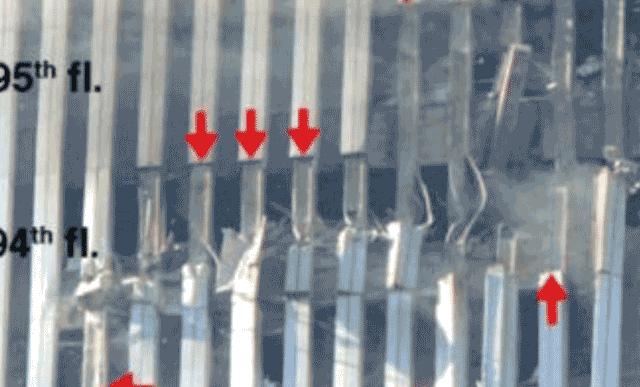
No plane in Shanksville, no plane at the Pentagon, and no planes at the WTC.
What caused the left-to-right pattern of columns 145-152?

reply to post by ProudBird
Better tell pteridine...he thinks it was a 757 and the photos are of poor quality.
The photos of United 175 are crystal-clear proof, it is a stock Boeing 767. All other claims are not only speculative, they are absent any common sense nor evidence.
Better tell pteridine...he thinks it was a 757 and the photos are of poor quality.
reply to post by Insolubrious
More idiotic drivel..
The WTC buildings were larger than a battleship at 1362 ft tall and 210 feet wide
IOWA class battleship (largest US Navy had) measures 887 ft x 108 ft
The battleships are also moving making more difficult to hit
Battleships also shoot back
WTC was not armoured, the steel exterior columns were 1/4 in steel
Battleships are protected by several inches of armour plate
Here is what happens to unarmoured ship when hit by fast moving aircraft
USS HINSDALE (APA 120)
USS STERRETT (DD 407)
More idiotic drivel..
The WTC buildings were larger than a battleship at 1362 ft tall and 210 feet wide
IOWA class battleship (largest US Navy had) measures 887 ft x 108 ft
Class and type: Iowa-class battleship
Displacement: 45,000 tons
Length: 887.2 ft (270.4 m)
Beam: 108.2 ft (33.0 m)
Draft: 28.9 ft (8.8 m)
The battleships are also moving making more difficult to hit
Speed: 33 kn (38 mph; 61 km
Battleships also shoot back
Armament: 9 × 16 in (410 mm)/50 cal Mark 7 guns
20 × 5 in (130 mm)/38 cal Mark 12 guns
80 × 40 mm/56 cal anti-aircraft guns
49 × 20 mm/70 cal anti-aircraft cannons
WTC was not armoured, the steel exterior columns were 1/4 in steel
Battleships are protected by several inches of armour plate
Armor: Belt: 12.1 in (310 mm)
Bulkheads: 11.3 in (290 mm)
Barbettes: 11.6 to 17.3 in (290 to 440 mm)
Turrets: 19.7 in (500 mm)
Decks: 7.5 in (190 mm)
Here is what happens to unarmoured ship when hit by fast moving aircraft
USS HINSDALE (APA 120)
USS STERRETT (DD 407)
reply to post by thedman
"Idiotic drivel", now there's a nice touch.
What's your story on how the 35 degree (per MIT) swept back wings of the jet could strike the columns head-on in a wedge-sawing motion from the right, yet bend them on the left and to the right?
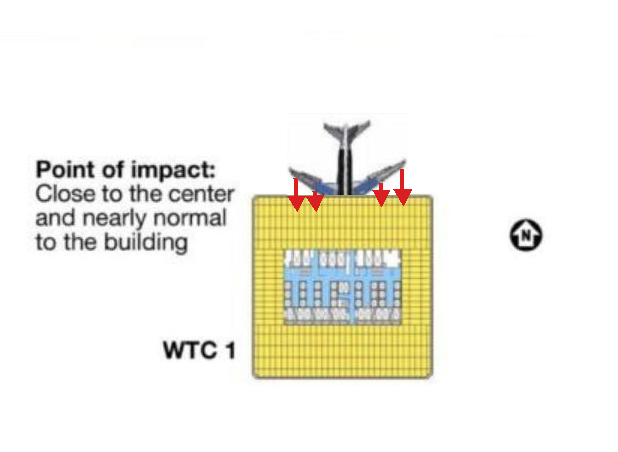

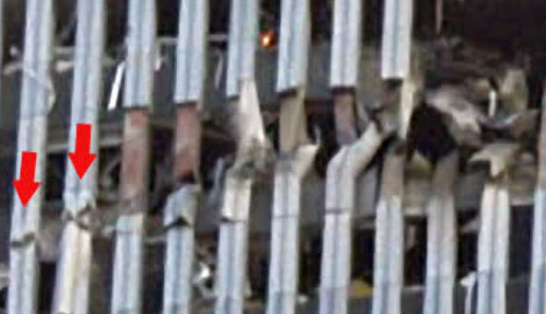
On both towers the left hand gashes are clearly outside-in, and nearly in exact relation to the floors. Funny thing is, the right side gash is much more steep for WTC2, than the hole shows on WTC1. Curious, considering both were 767s to have their left wing impacts be so similar while their right wing impacts be so different.
What could explain this video and the distinctly missing jet?
"Idiotic drivel", now there's a nice touch.
What's your story on how the 35 degree (per MIT) swept back wings of the jet could strike the columns head-on in a wedge-sawing motion from the right, yet bend them on the left and to the right?



On both towers the left hand gashes are clearly outside-in, and nearly in exact relation to the floors. Funny thing is, the right side gash is much more steep for WTC2, than the hole shows on WTC1. Curious, considering both were 767s to have their left wing impacts be so similar while their right wing impacts be so different.
What could explain this video and the distinctly missing jet?
edit on 3-12-2011 by septic because: (no reason given)
reply to post by thedman
Shaped like this:
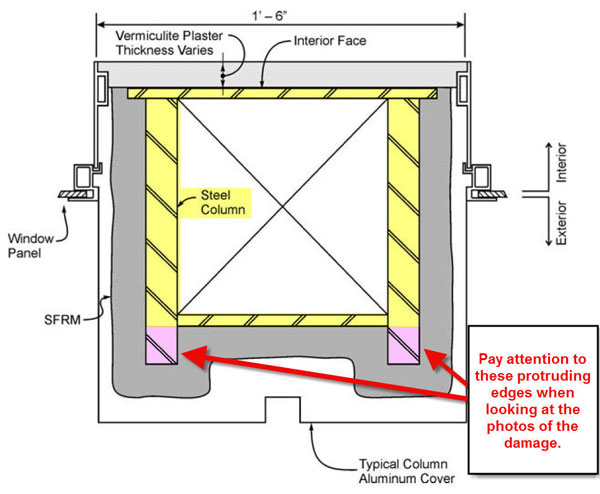
Meaning a rounded jet wing striking straight on

would look a lot like this:
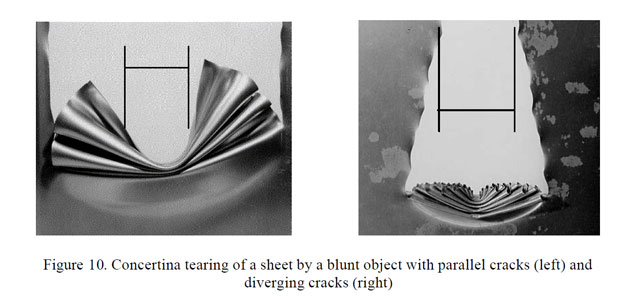
WTC was not armoured, the steel exterior columns were 1/4 in steel
Shaped like this:

Meaning a rounded jet wing striking straight on

would look a lot like this:

Originally posted by septic
reply to post by pteridine
Your lack of technical knowledge is absolutely astounding. Given your simplistic view of collision dynamics, why wouldn't the invisible missiles bounce off as soon as their wings struck the columns at an acute angle?
Good grief, how strong do you think those wings are?
Apparently, they were strong enough to break through the outer columns of the WTC, given that there is absolutely no evidence for anything else. Note in your posted photo that some of the columns seem to have their thinner center section removed and the "protruding edges" [your diagram] are pinched inwards at the breaks. This is the result of the center web being pressed out which caused the edges to bend inward. This deformation could not have occurred with an impact nearly parallel to the plane of the outer wall.
Now you can try to prove your theory by showing evidence of missiles, not misinterpreted photos and video frames.
Originally posted by pteridine
Originally posted by septic
reply to post by pteridine
Your lack of technical knowledge is absolutely astounding. Given your simplistic view of collision dynamics, why wouldn't the invisible missiles bounce off as soon as their wings struck the columns at an acute angle?
Good grief, how strong do you think those wings are?
Apparently, they were strong enough to break through the outer columns of the WTC, given that there is absolutely no evidence for anything else.
See? This is why i urge you to read the thread, or even your own posts. It could cure your myopia. You were talking about the missiles' wings deflecting the trajectory of the missile, which is what I was talking about.
Note in your posted photo that some of the columns seem to have their thinner center section removed and the "protruding edges" [your diagram] are pinched inwards at the breaks.
I note that's what you want to see, but no, those have been gouged.
The 12 inch by 60 inch 900 lb titanium tipped penetrating payload was traveling through the columns, dragging them right as it passed. Note on WTC2, you can see the gouged out column more clearly.

This is what your desperate eyes are mistaking for a "pinch".
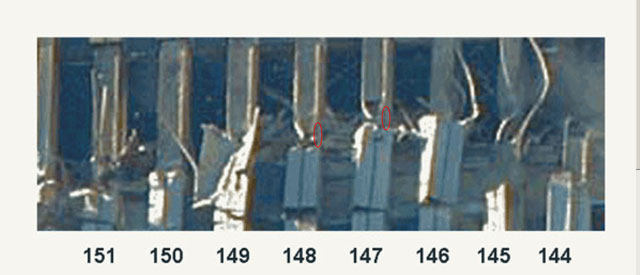
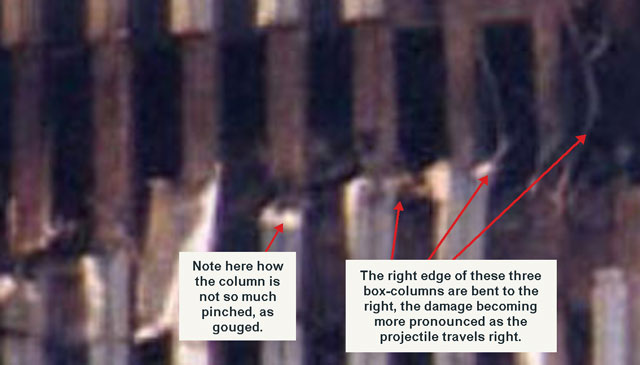
This is the result of the center web being pressed out which caused the edges to bend inward. This deformation could not have occurred with an impact nearly parallel to the plane of the outer wall.
Note the description of the projectile's warhead:
The warhead can be detonated as a long rod penetrator, an aerostable slug, or as fragments based on the hardness of the target.
Source
The evidence is consistent with this type of projectile striking at an angle and penetrating multiple columns prior to detonating. They came at an angle.
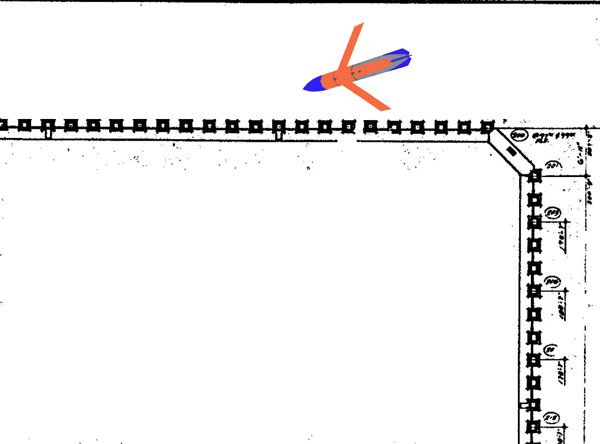
Missiles on the right had enough downward momentum to cut columns cleanly
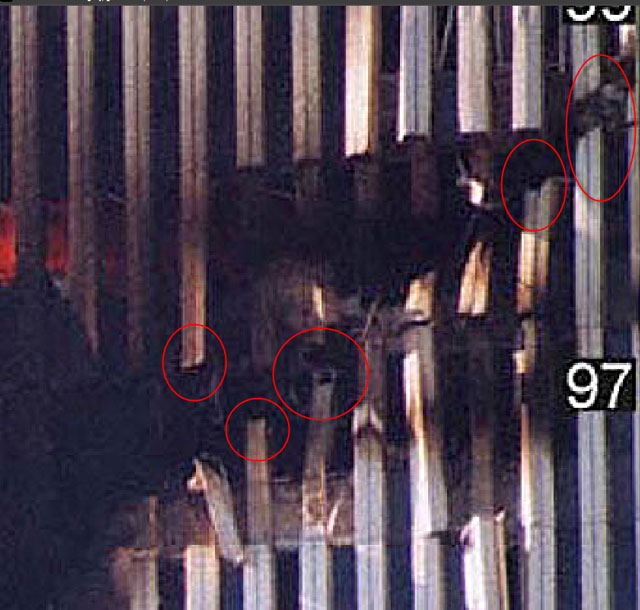
Missiles on the left weren't as lucky:


reply to post by septic
Look at your own photos and diagrams. The invisible missile had invisible wings which, before the invisible warhead even touched, hit the columns. Based on your analysis, the invisible missile should have been deflected.
Of course, if you ever do look closely at your photos, you will see some columns with the web knocked out and the stronger edges twisted. You will see some pinched inwards at the break. You still have not shown any evidence of all those missiles you claim did the work, you have not shown that their flight envelopes would allow for such maneuvers, and you have not shown how warheads could do the damage to make ot look like a plane struck the buildng.
Explain again why an airliner couldn't penetrate the towers.
Look at your own photos and diagrams. The invisible missile had invisible wings which, before the invisible warhead even touched, hit the columns. Based on your analysis, the invisible missile should have been deflected.
Of course, if you ever do look closely at your photos, you will see some columns with the web knocked out and the stronger edges twisted. You will see some pinched inwards at the break. You still have not shown any evidence of all those missiles you claim did the work, you have not shown that their flight envelopes would allow for such maneuvers, and you have not shown how warheads could do the damage to make ot look like a plane struck the buildng.
Explain again why an airliner couldn't penetrate the towers.
new topics
-
Groaners II
Jokes, Puns, & Pranks: 1 hours ago -
Lunacy
Short Stories: 1 hours ago -
Political Labels Quizzes
Political Ideology: 2 hours ago -
Why Dems Are Probably Wishing Trump Won in 2020...
US Political Madness: 2 hours ago -
Pure Love is simple.
Philosophy and Metaphysics: 3 hours ago -
Interesting timing 40 monkeys flee medical lab in US
Diseases and Pandemics: 3 hours ago -
All Talk No Walk Celebrities Blowing Smoke
US Political Madness: 5 hours ago -
Arizona and Nevada Called for Trump – Giving Trump 312 Electoral Votes
2024 Elections: 6 hours ago -
A question about abortion and the states
US Political Madness: 8 hours ago -
What shenanigans are at play with the house races?
2024 Elections: 9 hours ago
top topics
-
What shenanigans are at play with the house races?
2024 Elections: 9 hours ago, 12 flags -
Interesting timing 40 monkeys flee medical lab in US
Diseases and Pandemics: 3 hours ago, 11 flags -
Arizona and Nevada Called for Trump – Giving Trump 312 Electoral Votes
2024 Elections: 6 hours ago, 11 flags -
All Talk No Walk Celebrities Blowing Smoke
US Political Madness: 5 hours ago, 11 flags -
Young People and Social Media
Social Issues and Civil Unrest: 12 hours ago, 10 flags -
A question about abortion and the states
US Political Madness: 8 hours ago, 7 flags -
Why Dems Are Probably Wishing Trump Won in 2020...
US Political Madness: 2 hours ago, 6 flags -
Pure Love is simple.
Philosophy and Metaphysics: 3 hours ago, 3 flags -
Lunacy
Short Stories: 1 hours ago, 3 flags -
Political Labels Quizzes
Political Ideology: 2 hours ago, 2 flags
active topics
-
A question about abortion and the states
US Political Madness • 30 • : SideEyeEverything1 -
Can you prove that you are not a bot ?
General Chit Chat • 43 • : whereislogic -
On Nov. 5th 2024 - AMERICANS Prevented the Complete Destruction of America from Within.
2024 Elections • 97 • : WeMustCare -
DOJ moving to wind down Trump criminal cases before he takes office
Mainstream News • 27 • : marg6043 -
Political Labels Quizzes
Political Ideology • 2 • : ksihkahe -
Remember These Attacks When President Trump 2.0 Retribution-Justice Commences.
2024 Elections • 89 • : WeMustCare -
About that ''Iron Dome''
Other Current Events • 28 • : YourFaceAgain -
Maetaquest 3S
Video Games • 16 • : andy06shake -
President BIDEN's FBI Raided Donald Trump's Florida Home for OBAMA-NORTH KOREA Documents.
Political Conspiracies • 52 • : WeMustCare -
Arizona and Nevada Called for Trump – Giving Trump 312 Electoral Votes
2024 Elections • 30 • : awhispersecho
